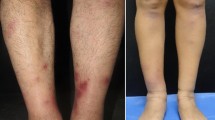Abstract
A subplantar injection of 5–100 μg adriamycin in the mouse hind paw produced a biphasic inflammatory response. The first phase peaked at 2h while the second, more severe phase peaked at four to five days. The magnitude of inflammation was dose related. Administration of [3H]adriamycin revealed that 78% of the drug was lost from the paw within one day. The loss of the remaining drug followed a biphasic decay curve. The first-phase half-life was 1.2 days, and the second-phase half-life was 16.0 days. Vascular permeability, as measured by the leakage of intravenously administered [125I]albumin, was increased between day 4 and day 8. Pathologically, the paw had mild edema and hemorrhage by 4 h after adriamycin injection. The most severe pathological response was seen at 5 days with diffuse inflammation characterized by edema of the dermis, cellular debris, and mononuclear inflammatory cells. By 10 days the inflammatory response was still present but the edema was milder. The antihistamine diphenhydramine, an H1-blocker, inhibited the first phase of inflammation at the highest dose tested but had no effect on the second phase of inflammation. The antihistamine metiamide, an H2-blocker; the antiserotonin drug, ρ-chlorophenylalanine; and the antiinflammatory drugs, aspirin, hydrocortisone, and ibuprofen failed to antagonize adriamycin-induced inflammation at 2 h or 5 days after adriamycin injection. Indomethacin reduced the inflammation after 5 days but only at toxic dose levels.
Similar content being viewed by others
References
Lancet, Editorial. 1974. Adriamycin and the heart.Lancet 1 (7870):1325.
Bowers, D. G., Jr., andJ. B. Lynch. 1978. Adriamycin extravasation.Plast. Reconstr. Surg. 61:86–92.
Rudolph, R., R. S. Stein, andR. A. Pattillo. 1976. Skin ulcers due to adriamycin.Cancer 38:1087–1094.
Reilly, J. J., J. P. Neifeld, andS. A. Rosenberg. 1977. Clinical course and management of accidental adriamycin extravasation.Cancer 40:2053–2056.
Momparler, R. L., M. Karon, S. E. Siegel, andF. Avila. 1976. Effect of adriamycin on DNA, RNA and protein synthesis in cell-free systems and intact cells.Cancer Res. 36:2891–2895.
Mailer, K., andD. H. Petering. 1976. Inhibition of oxidative phosphorylation in tumor cells and mitochondria by daunomycin and adriamycin.Biochem. Pharmacol. 25:2085–2089.
Myers, C. E., W. P. McGuire, R. H. Liss, I. Ifrim, K. Grotzinger, andR. C. Young. 1977. Adriamycin: The role of lipid peroxidation in cardiac toxicity and tumor response.Science 197:165–167.
Bertazzoli, C., andM. Ghione. 1977. Adriamycin associated cardiotoxicity: Research on prevention with coenzyme Q.Pharmacol. Res. Commun. 9:235–250.
Notari, R. E. 1975. Biopharmaceutics and Pharmacokinetics: An Introduction, 2nd ed. Marcel Dekker, New York. 22.
Dirosaa, M., J. P. Giroud, andD. A. Willoughby. 1971. Studies of the mediators of acute inflammatory response induced in rats in different sites by carrageenan and turpentine.J. Pathol. 104:15–29.
Dirosa, M., J. M. Papadimitriou, andD. A. Willoughby. 1971. A histopathological and pharmacological analysis of the mode of action of non-steroidal anti-inflammatory drugs.J. Pathol. 105:239–256.
Blackham, A., andR. T. Owen. 1975. Prostaglandin synthetase inhibitors and leucocytic emigration.J. Pharm. Pharmacol. 27:201–203.
Jarrott, B., A. Mcqueen, L. Graf, andW. J. Louis. 1975. Serotonin levels in vascular tissue and the effects of a serotonin synthesis inhibitor on blood pressure in hypertensive rats.Clin. Exp. Pharmacol. Physiol. Suppl. 2:201–205.
Saeed, S. A., andJ. Cuthbert. 1977. On the mode of action and biochemical properties of anti-inflammatory drugs. II.Prostaglandins 13:565–575.
Gryglewski, R. J. 1976. Prostaglandins and prostaglandin synthesis inhibitors in etiology and treatment of inflammation.In Proceedings of the Sixth International Congress of Pharmacology, Vol. 5, Clinical Pharmacology. M. J. Mattila, editor. Pergamon Press, New York. 151–160.
Ohuchi, K., andL. Levine. 1978. Stimulation of prostaglandin production, deacylation of lipids and morphological changes by tumor-promoting phorbol-12,13-diesters and adriamycin in MDCK cells: Effect of cycloheximide, indomethacin and hydrocortisone on these stimulations.Prostaglandins 15:723.
Menozzi, M., andF. Arcamone. 1978. Binding of adriamycin to sulphated mucopolysaccharides.Biochem. Biophys. Res. Comm. 80:313–318.
Shier, W. T., J. T. Trotter, III, andC. L. Reading. 1974. Inflammation induced by concanavalin A and other lectins.Proc. Soc. Exp. Biol. Med. 146:590–593.
Mayer, E. G., C. A. Poulter, andS. A. Aristizabal. 1976. Complications of irradiation related to apparent drug potentiation by adriamycin.Int. J. Radiat. Oncol. Biol. Phys. 1:1179–1188.
Willoughby, D. A. 1960. Pharmacological aspects of the vascular permeability changes in the rat's intestine following abdominal radiation.Br. J. Radiol. 33:515–519.
Giri, S. N., S. Rice, andP. Bacchetti. 1975. Characteristic features of actinomycin D-induced paw inflammation of the rat.Exp. Mol. Pathol. 23:367–378.
Lee, Y. C., andJ. E. Byfield. 1976. Induction of DNA degradaton in vivo by adriamycin.J. Natl. Cancer Inst. 57:221–224.
Goodman, M. F., andG. M. Lee. 1977. Adriamycin interactions with T4 DNA polymerase: Two modes of template-mediated inhibition.J. Biol. Chem. 252:2670–2674.
Goodman, J., andP. Hochstein. 1977. Generation of free radicals and lipid peroxidation by redox cycling of adriamycin and daunomycin.Biochem. Biophys. Res. Commun. 77: 797–803.
Noël, G., C. Peterson, A. Trouet, andP. Tulkens. 1978. Uptake and subcellular localization of daunorubicin and adriamycin in cultured fibroblasts.Eur. J. Cancer 14:363–368.
Borel, J. F. 1970. Studies on chemotaxis: Effect of subcellular leukocyte fractions on neutrophils and macrophages.Int. Arch. Allergy Appl. Immunol. 39:247–271.
Tappel, A. L. 1975. Lipid peroxidation and fluorescent molecular damage to membranes.In Pathobiology of Cell Membranes, Vol. I. B. F. Trump and A. Arstila, editors. Academic Press, New York. 145–170.
Myers, C. E., W. McGuire, andR. Young. 1976. Adriamycin: Amelioration of toxicity α-tocopherol.Cancer Treat. Rep. 60:961–962.+
Author information
Authors and Affiliations
Rights and permissions
About this article
Cite this article
Siegel, D.M., Giri, S.N., Scheinholtz, R.M. et al. Characteristics and effect of antiinflammatory drugs on adriamycin-induced inflammation in the mouse paw. Inflammation 4, 233–248 (1980). https://doi.org/10.1007/BF00914168
Issue Date:
DOI: https://doi.org/10.1007/BF00914168




